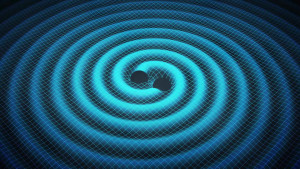On Thursday, February 11, scientists from the Laser Interferometer Gravitational-Wave Observatory (LIGO) announced they had made the first measurements of fluctuations in spacetime caused by gravitational waves – a monumental leap forward in modern physics. This discovery lends significant experimental evidence to Albert Einstein’s theory of general relativity and opens up doors to new techniques of listening to massive gravitational events in deep space.
Einstein proposed gravitational waves as part of his theory of general relativity in 1915. They were such an exotic part of nature that even he was unsure they could exist. There are many unsolved mysteries in our current theory of gravity and general relativity was an attempt to explain why gravity exists and what causes it. We exist in the four-dimensions of spacetime. Travel through the three-dimensions of space affects the speed with which we travel through time.
 To picture Einstein’s theory of general relativity, imagine those four dimensions as compressed into a tightly-stretched sheet of elastic. Any mass bends the spacetime around it. Place a bowling ball on the sheet and it stretches, sagging as it conforms to the weight. Roll a baseball in a straight line near the bowling ball on the elastic and it will begin to roll down towards the bowling ball, orbiting the more massive object.
To picture Einstein’s theory of general relativity, imagine those four dimensions as compressed into a tightly-stretched sheet of elastic. Any mass bends the spacetime around it. Place a bowling ball on the sheet and it stretches, sagging as it conforms to the weight. Roll a baseball in a straight line near the bowling ball on the elastic and it will begin to roll down towards the bowling ball, orbiting the more massive object.
Although this metaphor is imperfect, it illustrates the overall idea of general relativity: gravity is caused by the warping of spacetime around mass. If this is the case, we should observe effects of this in the universe. Many of these effects have been measured, such as the ability of gravity to bend light. One of the heretofore unobserved phenomena of general relativity was gravitational waves.
If we think back to the elastic metaphor and imagine two massive objects orbiting each other, we would observe ripples in the material emanating from this event at a steadily increasing rate. These are akin to the gravitational waves observed by LIGO. These waves stretch space in one direction and compress space perpendicular to this stretching. If you had incredibly sharp vision and two rulers in an “L” shape, you might think that you could observe one ruler getting longer and the other getting shorter as a gravitational wave passes through the area, but because it is space itself that fluctuates, you couldn’t observe the change using anything that has mass.
LIGO works on a similar principle to the hypothetical ruler experiment. However, instead of measuring distance with mass, light is used as a unit of measurement. An observatory contains two 4 kilometer tunnels kept at vacuum and arranged in the same “L” shape as the rulers. A single laser beam is split at 90 degrees to travel down both tunnels and reflect off a mirror. The wavelengths of the beams are then measured independently. If the length of either tunnel is altered by a distance 1/10000 of the diameter of a proton, the wavelength of the laser beam traveling down that tunnel will be altered enough to detect the change when compared to the beam traveling down the other tunnel. This is a common physics technique called laser interferometry, applied on an exceptionally large scale. There are two such LIGO sites in the United States, one in Louisiana and another in Washington State.
You would know you had measured a gravitational wave if one of the tunnels got longer and the other got shorter as a wave passed through the detection system. According to the New York Times, in September of 2015, both sites received the same signal, a fluctuation in spacetime equal to 4/1000 of the diameter of a proton. This almost imperceptible change matches to the predicted signal of two black holes orbiting each other faster and faster until they collapsed into a single black hole 65 times the mass of the Sun. This spectacular event in deep space sent out ripples in spacetime that are being observed now, over a billion years after it occurred.
This is a monumental step forward in physics. It is incredible evidence for Einstein’s theory of general relativity. It opens up questions about binary black hole systems. How do they occur in the first place? It advances our knowledge about the least understood fundamental force – gravity. On top of this, it is a meaningful achievement that marks what humanity can achieve through cooperation and hard work. This is a milestone in science that will inspire many graduate theses in the decades to come.
